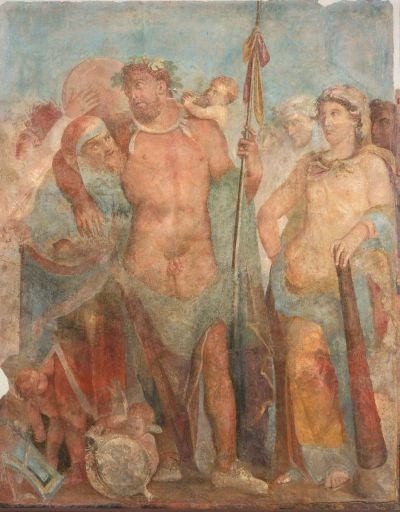Museo Civico Archeologico, Bologna
23.09.2022 - 19.03.2023

[아츠앤컬쳐] 2022년 9월 23일부터 2023년 3월 19일까지 볼로냐 시 고고학박물관에서 폼페이 회화전이 열린다. 오클라호마시립미술관과 뉴욕대학교 고대세계연구소의 호평에 이어, 이탈리아로 돌아가 유럽 가을 전시의 가장 기대되는 전시 중 하나로서 훨씬 더 많은 작품들로 확장 전시된다. 세계에서 가장 큰 고고학 회화 갤러리인 나폴리 국립고고학박물관과 협력하여 18세기의 발굴 이래로 나폴리를 떠난 적이 없는 100개 이상의 희귀한 프레스코화 작품을 전시한다. 로마 미술 전문가 마리오 그리말디의 큐레이션에 몬도 모스트레 제작으로 고대 걸작들을 창작하는 데 사용된 독창적인 도구들과 폼페이우스 방을 재건하여 대화하면서 볼 수 있는 기회를 제공하며, 부르봉 고고학자들이 발굴한 벽화와 물품들을 특징으로 한다.
Exhibition curated by Mario Grimaldi, presented at the Museo Civico Archeologico, Bologna, in collaboration with the Municipality of Bologna and the National Archaeological Museum of Naples, and produced by MondoMostre.
From 23 September 2022 - 19 March 2023, the Museo Civico Archeologico di Bologna presents The Painters of Pompeii. Following critically acclaimed presentations at Oklahoma City Museum of Art and New York University's Institute for the Study of the Ancient World, the exhibition expands with a much greater number of works as it returns to Italy and marks one of the most anticipated exhibitions of the autumn exhibition season in Europe. Presenting over 100 rare frescoes, with almost half having never left Naples since they were excavated in the 18th-century, the show is in collaboration with the National Archaeological Museum of Naples – the largest archaeological painting gallery in the world. Curated by Roman art expert Mario Grimaldi and produced by MondoMostre, it offers the opportunity to view ancient masterpieces in dialogue with the original tools used to create them and reconstructions of Pompeian rooms, featuring wall paintings and items dug by Bourbon archaeologists.
The exhibition draws a renewed focus on the pictores: artists and craftsmen who created the wall decorations in the houses of Pompeii, Herculaneum and the Vesuvian area. Very little information is known about these makers, with their artworks widely baring no signature. Since revealed by the Bourbon excavations, the artifacts they left behind act as valuable pictorial testimonies of Vesuvian life and its organisation. The Painters of Pompeii seeks to contextualise the pictores’ role and economic condition in Roman society whilst highlighting their techniques, tools, colours, and models. Through the wealth of images preserved after the eruption in 79 AD – namely vibrant, often large-scale frescoes – we see a reflection of the tastes and values of various clients while gaining a greater understanding of their production system.

Masterpieces from various domus (ancient Roman dwellings famous for the beautiful wall decorations from which they often take their name) will be exhibited in Bologna. For example, works will feature from Pompeii’s The House of the Tragic Poet, and The House of Punished Love, as well as Boscoreale’s The Villa of Fannio Sinistore and Herculaneum’s The Villa of the Papyri. With the largest fresco never having been moved before and standing at a huge 5 by 3 meters, these works allow us to explore a scope of colours which were ubiquitous in antiquity and whose traces would have been lost to us, if not for the rediscovery of Pompeii, Herculaneum, Boscoreale or Stabiae.
Visitors will gain insight into a wide selection of the most popular compositional schemes across the different periods of Roman art, observing how some artists were able to give an original vision of decorative models, continuously varied and updated in line with local fashions and styles. Subjects span lively depictions of guests being welcomed, refined images of landscapes, gardens and architecture, as well as recreations of mythical scenes.
The exhibition will additionally showcase the original technical tools found from the Pompeian excavations which painters used for designing and executing their works, as well as items placed by the Romans inside the rooms. Technical tools include cups that are still filled with colours from two thousand years ago, squares, compasses, plumb lines and preparatory drawings. Decorative and functional objects are also depicted in the frescoes exhibited, with artistic representations of tricliniums (a Roman couch extending around three sides of a table), oil lamps, jugs and vases in conversation with the preserved ancient artefacts on display.

|
These elements aid in the reconstruction of Pompeian rooms, such as those of the House of Jason and the large spectacular frescoes with stucco reliefs in the House of Meleager, as the exhibition is staged through the eyes of the pictore who would be adjusting their paintings to the actual context they were working in. With many works positioned and lit to reflect their placement in their original dwellings, the setup illustrates an artwork’s relation to its environment as a result of carefully considered messaging.
|

